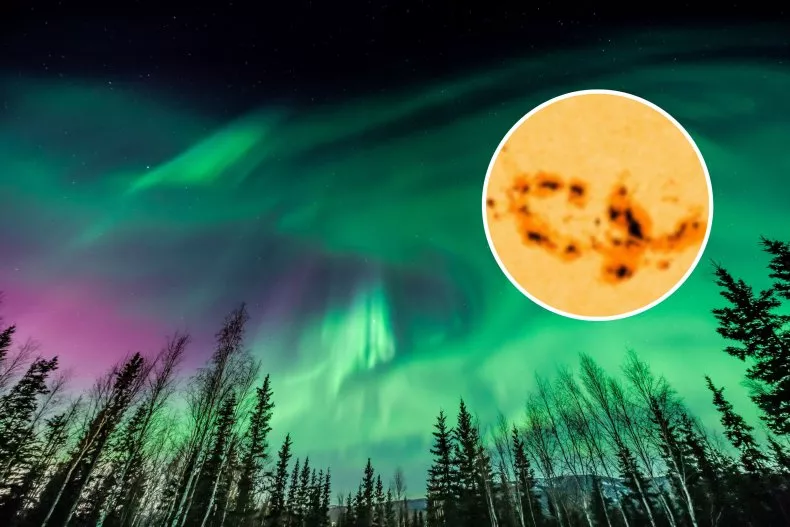The Power of Solar Phenomena: Understanding Sunspots, Solar Flares, and Geomagnetic Storms
The skies recently lit up with dazzling auroras, painting the horizon with vivid greens and pinks that mesmerized onlookers worldwide. These breathtaking light shows, while beautiful, are just the visible face of a much more powerful and potentially disruptive phenomenon originating from our closest star—the Sun. At the heart of these events are sunspots and solar storms, which not only create spectacular visual displays but also pose significant challenges to our technological infrastructure. As we approach a period of heightened solar activity, understanding the dynamics of these solar phenomena becomes increasingly crucial. In this article, we delve into the fascinating world of sunspots, solar flares, and geomagnetic storms, exploring their causes, impacts, and what we might expect in the coming months.
The Return of Sunspot AR 3664/AR 13697
The Sun, our life-giving star, has been exceptionally active recently, leading to stunning auroral displays and significant solar phenomena. At the heart of this activity is the sunspot initially known as AR 3664, which has returned to our view after its journey around the far side of the Sun. Renamed AR 13697 upon its reappearance, this sunspot region has reignited interest and concern among scientists and space weather enthusiasts.
Sunspots are cooler, darker regions on the Sun’s surface, characterized by intense magnetic activity. These areas are crucial in the formation of solar flares and coronal mass ejections (CMEs). Solar flares are sudden bursts of radiation caused by the release of magnetic energy, while CMEs involve large expulsions of plasma and magnetic fields from the Sun. Both phenomena can significantly impact Earth, affecting radio communications, power grids, and even satellites.
In early May 2024, AR 3664 was responsible for a series of powerful solar flares and CMEs, culminating in a G5 geomagnetic storm—the strongest since 2003. This storm led to widespread auroras, visible even in regions unaccustomed to such displays, and caused temporary disruptions in communication systems. On its return, AR 13697 has already shown its potential by releasing an X2.9-class solar flare on May 27, 2024. This flare, though not as powerful as previous ones, still indicates the sunspot’s capability to produce significant solar events.
Predicting the behavior of such sunspots is a critical but challenging task. While scientists can monitor and model solar activity to some extent, long-term forecasting remains elusive due to the Sun’s complex and dynamic nature. The recent flare from AR 13697 has highlighted the ongoing need for vigilance as it continues its rotation across the Sun, potentially bringing more solar activity into Earth’s direct line of impact in the coming weeks.
The Power of Solar Flares
Solar flares are among the most powerful and fascinating phenomena that occur on our Sun. These sudden bursts of energy are the result of magnetic activity and can have far-reaching effects on Earth. When a solar flare erupts, it releases an enormous amount of energy, equivalent to millions of nuclear bombs detonating simultaneously.
Sunspot AR 3664 has been a significant source of solar flares recently. Earlier this month, it unleashed a series of powerful flares that caught the attention of scientists worldwide. The most recent activity included an X 2.8 flare, showcasing the sunspot’s capability to produce high-energy events even as it diminishes.
The impact of solar flares on Earth can be profound. They can disrupt radio communications, interfere with navigation systems, and even affect power grids. NASA has emphasized the potential risks, noting that flares and solar eruptions can pose dangers to spacecraft and astronauts. These bursts of energy can also cause temporary radio blackouts on the sunlit side of Earth, affecting aviation and maritime operations.
The May 2024 Geomagnetic Storm
In May 2024, the Earth experienced a geomagnetic storm of exceptional intensity, reaching a G5 level—the highest on the geomagnetic storm scale and a rarity since the Halloween storms of 2003. This storm was triggered by a series of coronal mass ejections (CMEs) originating from the sunspot region AR 3664, which had already made headlines for its hyperactivity.
The geomagnetic storm brought about spectacular auroral displays, visible far beyond the usual polar regions. Observers reported seeing the northern lights as far south as Florida, Mexico, and even Puerto Rico, while in the Southern Hemisphere, the auroras extended to unusual latitudes as well. These vibrant light shows were the result of charged particles from the Sun interacting with Earth’s magnetic field, causing gas molecules in the upper atmosphere to emit light in various colors.
The storm’s intensity was partly due to the arrival of multiple CMEs in quick succession, which combined to create a significant geomagnetic disturbance. This bombardment temporarily weakened Earth’s protective magnetic field, allowing more solar particles to penetrate the atmosphere and enhance auroral activity.
While the visual spectacle was awe-inspiring, the storm also posed challenges for technology. The U.S. National Oceanic and Atmospheric Administration (NOAA) issued a severe storm warning, leading to precautionary measures such as putting satellites into safe mode and powering down sensitive instruments. Despite these preparations, there were still reports of minor power grid irregularities and temporary disruptions to GPS and other satellite services.
Community Response
During the peak of the storm on May 10-11, 2024, the auroras were visible far beyond the usual polar regions, reaching as far south as Florida, Mexico, and Puerto Rico in the Northern Hemisphere, and equally unusual latitudes in the Southern Hemisphere. The vibrant displays of green, purple, and red lights were captured in stunning photographs and shared widely across social media. For many, this was a once-in-a-lifetime experience, as they had never seen auroras from their locations before.
NASA’s Aurorasaurus project played a significant role in documenting this event. The project, which relies on citizen scientists to report aurora sightings, received an overwhelming number of reports and images from around the world. These contributions were invaluable for scientists studying the event and for verifying aurora visibility predictions. Elizabeth MacDonald, a space physicist at NASA, noted, “Large storms visible this far south are so rare, and we have few chances to study them. Photos from citizen scientists can help us with that.”
Predicting and Observing Auroras
Scientists use a combination of ground-based observatories and space-based instruments to monitor the Sun’s activity. One of the primary tools is the Solar Dynamics Observatory (SDO), which provides high-resolution images of the Sun’s surface, allowing scientists to observe sunspots and solar flares as they develop. The European Space Agency’s Solar and Heliospheric Observatory (SOHO) also plays a critical role by providing data on solar wind and CMEs.
Despite these advanced tools, predicting the exact timing and impact of solar events remains challenging. Solar flares and CMEs can occur suddenly and with varying intensities, making long-term forecasting difficult. The magnetic complexity of sunspot regions, such as AR 13697, is a primary factor in determining their potential to produce significant solar flares. As AR 13697 continues its rotation across the Sun, scientists closely monitor its magnetic field to assess the likelihood of strong flares and their potential impacts on Earth.
Geomagnetic storms, driven by solar flares and CMEs, can have widespread effects on Earth’s technological infrastructure. These storms can cause disruptions to radio communications, GPS signals, and power grids. For instance, the May 2024 geomagnetic storm led to temporary radio blackouts and minor power grid irregularities. Understanding and predicting these storms are vital for mitigating their impacts on modern technology.
Maximizing Your Aurora Viewing Experience
As we approach the peak of the current solar cycle, known as the solar maximum, the frequency and intensity of solar activity are expected to increase. This period of heightened activity is anticipated to last through late 2024 to 2025, with more geomagnetic storms likely. While another G5 storm, like the one in May 2024, is challenging to predict, conditions are favorable for frequent G3-G4 storms, providing more opportunities for auroral displays at lower latitudes.
Observing auroras can be a breathtaking experience, and with the right conditions and preparations, you can maximize your chances of witnessing these spectacular natural light displays. Here are some practical tips to help you plan your aurora viewing:






